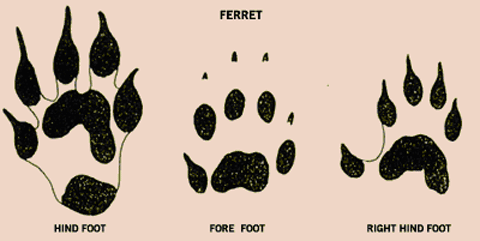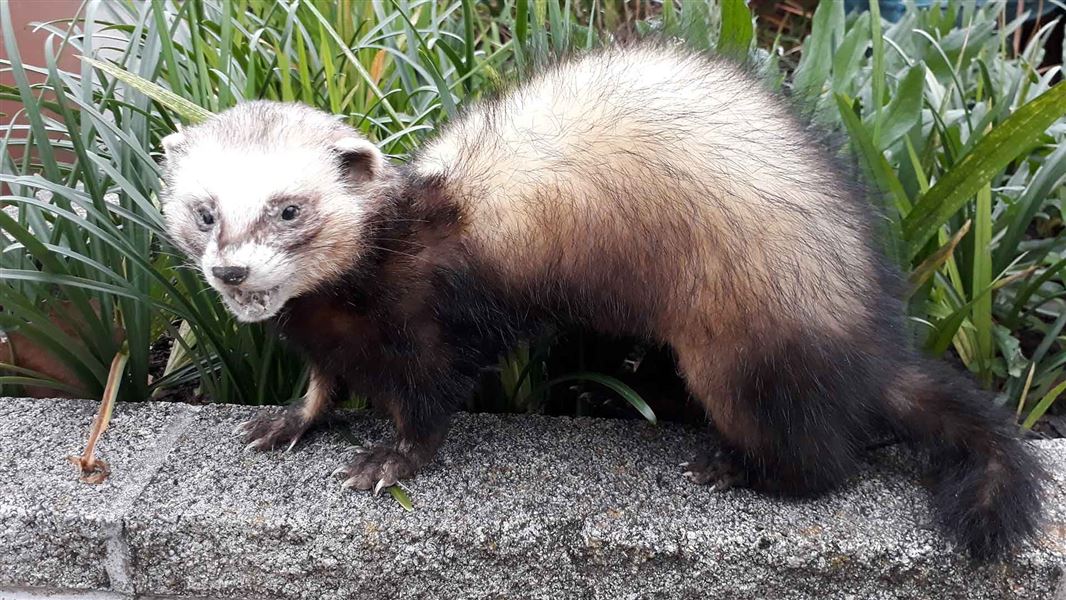Ferrets are an unwanted organism in New Zealand. To handle an unwanted organism, you'll need to apply for permission from the Ministry of Primary Industries (MPI).
Find information and apply for permission to handle a unwanted organism on MPI's website.
Description
Ferrets are small predators and are members of the mustelid family, along with stoats, weasels, badgers, mink and otters.
Stoats, weasels and ferrets, the only mustelids present in New Zealand, pose a serious threat to our threatened wildlife.
Since 2002, the sale, distribution and breeding of ferrets as domestic pets has been banned in New Zealand.
History of ferrets in New Zealand
Ferrets were introduced to New Zealand from Europe in the 1880s, along with stoats and weasels, to control rabbits that were breeding out of control. By 1900, ferrets were well established in the wild and definitely played a role in the decline of native birds like the kiwi, weka and blue duck, and the extinction of kākāpō on the mainland.
In the 1980s, at least 17 ferret farms were established in Northland. When these closed down due to a downturn in the market, many ferrets escaped or were set free, contributing to the expansion of ferrets northwards into some of New Zealand's remaining prime kiwi habitat.
Physical description
The ferret is the largest mustelid in New Zealand, with a body length of 320 mm-460 mm and a tail of 110-180 mm.
Males are noticeably larger than females, averaging 1.1-1.3 kg (max 1.85 kg) with females ranging from 400-1,100 grams. Ferrets are considerably larger and of ‘stockier’ build than stoats.
The colour is variable, with a typical white or cream undercoat and a variable quantity of longer dark guard hairs, giving some animals a black looking appearance while others appear almost white.
The tail is uniformly dark. A variable dark mask occurs across the eyes and above the nose.
Prey
The main food of ferrets is rabbits and hares. Densities of ferrets seem to be strongly correlated with density of rabbits. A sudden reduction in rabbit numbers, as with the introduction of RCD/RHD but also with natural fluctuations, means that hungry ferrets attack other animals like threatened native species.
Rodents, possums and ground-dwelling or nesting birds are all frequently taken. Lizards, eels, frogs, insects, eggs, hedgehogs and carrion are minor prey items.
Behaviour
They are mainly nocturnal, with a home range that is variable according to food supply, from 3-70 ha. A ferret will usually exclude others of the same sex from its central home range. Scent glands are used extensively to leave territorial scent markers.
Mating of ferrets usually occurs in September. The litter, usually of 4-8 (up to 12), is born in October or November, with young independent by late January. Females can have a second litter after this if food is abundant.
There is high mortality in the first year, and an average lifespan in the wild may be 4-5 years.
Ferrets are generally absent or in low numbers in areas of high rainfall, where there are few rabbits, or deep within forested areas.
Ferrets will often revisit the site of a kill.
Impact on native species
While ferrets have been in New Zealand for over a century, they are still having huge impacts on vulnerable native species. No equilibrium with the environment has been reached - native species are still declining because of ferrets.
It was originally thought that ferrets were limited to open country like pasture, scrubland and coastal areas, and in the fringes of nearby forests; however, research has found ferrets within some Northland forests placing added pressure on already threatened kiwi populations. The decline of kiwi in Northland has been greatest in the south, which is the area where ferrets are most prevalent.
One of the biggest challenges is to maintain ferret-free islands and areas like Stewart Island and Great Barrier Island and reserves that are home to threatened species. The arrival of ferrets in places like these would be lethal for flightless and ground-dwelling birds.
Ferrets are not as widespread as stoats. However, ferrets have a significant effect on many riverbed breeding birds eg. black stilt, dotterel species and pied oystercatcher.
Ferrets are known to prey on royal albatross chicks, yellow-eyed penguin and little penguin, weka , North Island kiwi , and numerous freshwater wetland birds (eg. ducks).
They are considered as one of the major causes of decline of the white-flippered penguin, and as a significant and probable main cause (along with cats) of massive range contractions of grand and Otago skinks.
Ground-nesting birds like the rare New Zealand dotterel and extremely rare black stilt, flightless birds like the kiwi, rare lizards and insects are eaten by ferrets. Even the yellow-eyed penguin, blue penguin and royal albatross are not safe from ferrets. Ferrets love eggs and attack and kill chicks and adult birds - even adult kiwi. Threatened giant weta make a tasty snack, and geckos and skinks are not immune from the dangers ferrets pose.
Species found in the same areas as rabbits are more at risk than others. For example, the black stilt in the rabbit-prone Mackenzie Basin and the New Zealand dotterel on the Coromandel's coastal dunes. However, kiwi are particularly at risk where they share their forest home with ferrets that specialise on rats and mice rather than rabbits. These ferrets are more likely to supplement their rodent diet with kiwi.
Ferrets even threaten New Zealand's farming industry as they can carry bovine tuberculosis (Tb), as possums do. In some possum-free areas, ferrets have tested positive for Tb.
You can help
Signs that ferrets are present
Strong eye-shine at night.
Scats are similar to stoats and weasels but much larger, usually 70 mm long and 10 mm wide. Black colour with twisted tapering ends, usually full of fur, feathers and bone fragments.
Scats are often deposited in prominent positions, and obvious latrine areas are sometimes located near den entrances.
Prints similar to, but larger than, stoat:

The bounding gait of a ferret:

Methods of control
Trapping and poisoning are methods used for controlling ferrets.
Traps
The main control method is the DOC 250 trap, which is a powerful and effective kill trap.
To be safely set, however, the trap need to be placed inside a tunnel-like trap-box to ensure that birds, children or pets cannot get access to it. The box also orients the ferret in the right direction to be caught in the trap, disguises the trap, and protects it from the weather. Surprisingly, tunnels also seem to draw a ferret's interest.
A simple wooden tunnel can easily be built at home.
DOC 250 trap instructions (PDF, 210K)
The tunnel should be placed along a natural runway so that approaching animals must either pass over the trap or turn back. Suitable sites are along fences, hedges or the banks of a stream, in bush among tree roots, beside fallen logs or in dry culverts. The entrance must be cleared of leaves and weeds.
It is preferable to bait traps, though a well-placed trap can still catch ferrets without bait. Fishy cat food or freshly killed rabbit or chicken is excellent but does not keep well. A longer-lasting alternative is an egg which can be left whole or broken. Alternatively two eggs can be used. Make a small hole in one egg to provide a scent and leave the second egg whole to provide a long-lasting visual lure.
Setting the trap can be a little tricky, so make sure you follow the manufacturer's instructions and take care with fingers.
Ferrets are very difficult to catch so don't expect instant results. Three or four captures per trap in a year is a very good result. If ferrets are avoiding your traps, try leaving the tunnel empty for a time. Even the wariest old adults will get used to running through the tunnel and will be caught when the traps are next set. You can also try cutting a section out of the base of the tunnel, so that the traps are set level with the ground. Or try laying scent trails by taking a piece of fish or meat bait for a walk on a string from the tunnel out in various directions.
Predator-proof fence
Will exclude other pests as well.
Training
If you are planning a pest control operation enrol for these courses:
- Predator trapping methods
- Vertebrate pesticide control methods
See field-based courses for details.
Monitoring your control
All operations require monitoring.
One technique it to use tracking tunnels: How to monitor using tracking tunnels
Related links
- Predator Free New Zealand Trust website Information about humane kill traps
- Northland Regional Council website Information about mustelid control
- IUCN SSC Invasive Species Specialist Group (ISSG) website the management of ferrets
Monitoring your control
All operations require monitoring below are examples of methods used.
Tracking tunnels
A technique for monitoring mustelid activity using 'run-through' tunnels containing tracking paper and a tracking pad (ink or food colouring).
Related links
- Predator Free New Zealand Trust website Information about humane kill traps
- Northland Regional Council website Information about mustelid control
- IUCN SSC Invasive Species Specialist Group (ISSG) website the management of ferrets
